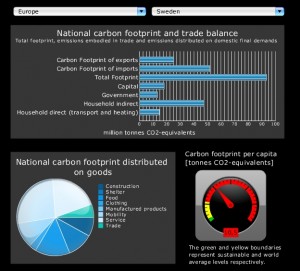 The diagram above shows the emissions resulting from how Swedes live. (Click on the picture to access the calculator for YOUR country.)
The diagram above shows the emissions resulting from how Swedes live. (Click on the picture to access the calculator for YOUR country.)
They say a picture is worth a thousand words … and this one has certainly made me think.
Firstly, here in Sweden we hear how proud we are of our climate strategy. That we are so sparing with our emissions, normally quoted as less than 6 tonnes per capita. This is truth modified when you realise that indirect emissions from imports are not included, and bring us well over 10 tonnes per capita.
Most of Sweden’s electricity production comes from non-fossil sources. About half is from hydro power and wind, the rest nuclear power. We do import some coal-fired electricity at peak.
A lot of Sweden’s district heating comes from renewable resources such as biofuel and rubbish incineration. Because of this, you regularly hear that Sweden will create whole fossil-free city districts within the next ten years. Looking at this diagram you have to wonder. Again, ignoring the emissions from construction, transport, manufacturing, food and services SOME districts MAY be fossil free.
Looking at this diagram, if you were to fashion a fossil-fuel independence strategy, some points emerge according to my first reading:
- Only 26% is actually emitted on food and shelter, so the priority must be to ensure food and shelter security on one hand
- At the same time we need to reduce the two largest emitters – mobility 26% and service 21%.
- This requires something new: designing our settlements so they do not need transport, and reducing the fossil fuel needs of the service sector. It is very much much a design issue, and could be done using available techniques.
- The next thing to do is to redesign manufacturing and its concomitant supply chains to need radically less fossil fuel. I have made a start on that one read my STORY FROM THE FUTURE.
- Looking at the diagram, the longer business as usual is left to continue, the less profitable current investments will become. This is because we must expect either a rapid rise in fuel prices or a radical investment in renewables and nature-does-the-work solutions by competitors. Read my ideas on this in another STORY FROM THE FUTURE, this time on truly low-energy cities.